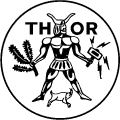News
Day 17: Special rituals in a temple
Saturday March 12th, 2011 by Rick van Kemenade
Today the participants woke up in Kyoto for the last time. The morning program was free. Many spent the morning at the imperial palace, where they had applied earlier during the week to be able to visit. The fact that the palace was across the street from the hotel made this a very convenient excursion. Others decided to wake up late to recover from the tiring days that preceded this one.
Early in the afternoon the entire party gathered at Kyoto’s central station. From here, we took the JR train to Osaka, from where we travelled on to Shigisan, a small town in the Nara prefecture. The large luggage had been sent ahead to Osaka, since it would only cause inconvenience at the temple. There was a plan to walk up the hill that housed the temple. Unfortunately it started raining when we arrived at the station and we were slightly behind on schedule, so the group boarded a bus instead.
The full bus clearly had a rough time tugging 32 Europeans up a mountain. We finally made it to the right bus stop and entered the Senju-in Temple complex. We were welcomed by the monks who reside there. The men and women were taken to separate sleeping halls and the rules and (early) timetable were explained. After that we enjoyed a very special diner on our knees, with new and interesting flavours for all.
After diner, there was time to walk around the temple area. Some decided to walk all the way up the hill, while others watched the devastating earthquake news (fortunately far away from our area) on a small television screen. Later on, there was time to enjoy the hot tub and lights went out at 22:00, to rise very, very early the next morning.




Day 16: Bicycle Mayhem
Friday March 11th, 2011 by Celine Vincent
Kyoto is not as large a city as Tokyo or Nagoya. When we first arrived in Kyoto, the lack of skyscrapers even seemed strange to us. But Kyoto is still a large city and most of the must see attractions are located near the edges of the city. Since we could not walk or use the pulic transport to visit everything we wanted in one day, we decided to rent bicycles and cycle there instead.
Riding a bike in a Japanese city is an experience by itself. Although public transport and most traffic we have seen is well organized, the same cannot be said of the sidewalks, which bikers and pedestrians share. In Japan, cars ride on the left side of the street, but on the curbs this is not the case. Here you ride where you please and you should always try to choose the most illogical side. Sometimes a part of the sidewalk is marked for bicycles, but both Japanese bikers and pedestrians seemed to ignore this completely. Add to that the fact that nobody looks for bikes before crossing the curb or taking a turn and the noises of the city completely muffled our bells, riding a bike was most definitely an adventure by itself.
But the bikes were merely the means to visit some must see spots. In the morning we visited the Toji Temple and the Fushimi Inari Shrine. Toji Temple is known for its five-story pagoda, which is the highest wooden structure in Japan. This pagoda is also the symbol of Kyoto, so a sight we could not miss. Fushimi Inari is also a very impressive place for the many torii’s there. More than 1300 torii’s are placed over a four kilometer path with beautiful nature and spectacular views along the way.
In the afternoon Nijo Castle, the Ryoanji Zen Temple and Kinkaku-ji, the Golden Pavilion, formed our program. Nijo Castle offered beautiful sights both inside the castle, with its many wall paintings, and outside, where there was a large garden. The Ryoanji Zen Temple offered some participants a glimpse of the satori, the enlightenment that our study tour was named after when seeing the rock garden there. The Golden Pavilion, a building covered with gold leaf and surrounded by a Japanese garden, was also very impressive to see.
After this amazing day in Kyoto, it was time to pack our suitcases, which will be sent to our hotel in Osaka. But before we will go there as well, we will spend the night at a temple near Nara. A tea ceremony, traditional meals and sleeping on futons (the traditionsal bedding) promise to be quite the experience, but more on that in our next post.




Day 15: Omron
Thursday March 10th, 2011 by Celine Vincent
After all the cultural sights we saw yesterday, it was again time for a corporate excursion. Omron had an entire day prepared for us at two different locations, both some distance from Kyoto. We had had a chartered bus at our service and left Kyoto for the day. From our bus, we even got a glimpse of the beautiful nature in the Japanese countryside.
The first location we visited was the Kusatsu plant, where we were welcomed and introduced to Omron. Furthermore, we were shown around the production floors by someone who had worked for Omron in the Netherlands. He even surprised us with some Dutch! As some of us had visited the Omron plant in Den Bosch a year before coming to Japan, it was interesting to compare the two factories. A fantastic lunch (or should I say: four course meal) had been prepared and we made the interpretor work hard when we were given some time to ask our questions to the managers of the plant.
In the afternoon, we were invited to the Keihanna Innovation Center. This R&D facility is located at the center of Kyoto, Osaka and Nara. We were given a short introduction of Omron and a tour around the new and enormous building. Housing only 200 researchers, it was designed to create the most pleasant working atmosphere, but it also housed some impressive cleanrooms. A presentation about face recognition techniques and some time to ask our questions concluded the program.
In the evening, the study tour committee once again treated the participants to a diner in an izakaya, a traditional Japanese restaurant. Here, more than half of us decided to go for the unlimited drinks option, already nicknamed ‘adje toko’ by some. Let us hope they are not too tired for the bicycle ride through Kyoto, which is planned for tomorrow.



Day 13: Cars and a Shinkansen
Monday March 7th, 2011 by Perry van Schaijk
Before going to Toyota everybody ate the breakfast they bought yesterday. This time, we traveled by chartered bus. As we would be going to Kyoto in the afternoon and would not come back to the hotel anymore, everybody had to bring their belongings. With some difficulty we finally managed to fit everything into the bus.
Toyota showed us how they make cars in their factory. The Toyota assembly line is constantly moving, transporting multiple types of cars. Workers and cars stand on the same conveyor belt and so do the tools they use. Every worker has a specific task to complete before the car gets to the next station. Toyota implemented many features to enlarge the throughput of the belt. For example, all boxes containing parts have a light on them. When the light is green, the part is needed in this step and when it is blue it is needed but the worker already picked it up. Another part of the factory housed a practice area where you could test your skills at assembling a car. Most of us tried to do some of these “games” but they proved to be far more difficult than they looked. At the end of the tour we had the opportunity to take a look at the welding shop where we got an impressive view of numerous, simultaneously moving robot arms.
The next item on the agenda was the Toyota museum. At the entrance were two robots, one could actually play the trumpet with his “mouth”. The other robot demonstrated Toyota’s vision on future transportation. Toyota’s vision is that everybody should have his or her own transportation device which can be used in cities and on highways. The rest of the museum showed new technologies of Toyota, including fuel cells, but also showed the history of the company. The end of the tour presented the latest car models Toyota produces.
After Toyota, we moved on to Kyoto. Unfortunately, we had to take a minor detour as a participant had left his suit in the hotel. After riding the Shinkansen once again, the muscles of the participants were tested one last time before entering the hotel as it took many stairs to get to and from the subway in Kyoto. Checking in went smoothly and now everyone is enjoying their free time in a city full of cultural beauty.













